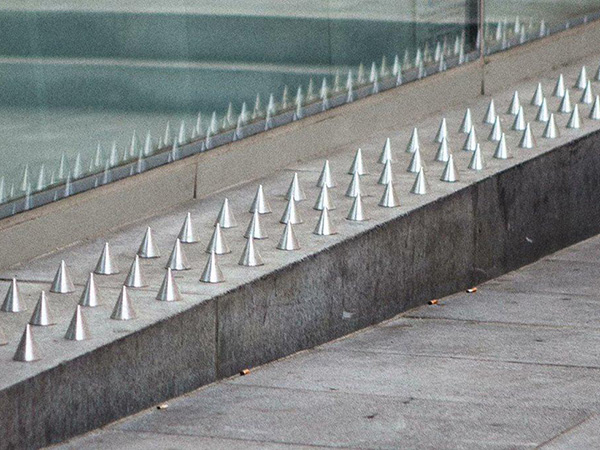There is a concept within design known as “hostile architecture” which describes attempts to use built environment to modify behaviour. As soon as you learn about this you will start to see it everywhere writes Alex Smale in CBD News recently.
A common example is skate stoppers, which are metal strips often on ledges and railings which are there to deter skateboarders. A more egregious example would be spikes placed on the ground to deter homeless people from resting.
From improper waste disposal to vandalism, bad behaviour is very common in strata properties. While it can be difficult to control the behaviour of residents, one thing committees do have some control over is the built environment. Committees should think about how they can modify their buildings to encourage good behaviour.
According to another recent article in Indesignlive, the point of hostile architecture – also known as Crime Prevention Through Environmental Design (CPTED), in case you’re wondering whether urban planners see conditions like being poor, homeless and/or young as being a deliberate criminal act these days – is to change people’s behaviour in public.
While some of it seems pretty benign – like those metal spikes inside awnings to deter birds from perching and pooing all over the place, other examples seem very hostile indeed, like metal spikes on the ground under enclosed areas to deter homeless people from sleeping there.

However, the problem with hostile architecture is that it has an oppressive effect on those who use these spaces. Coming home every day and seeing spikes or deterrents, would likely have a depressive impact on residents and does not encourage community or pride in one’s home.
There are ways for strata communities, however, to take the lessons of hostile architecture to do the opposite: amend the built environment in positive ways to encourage good behaviour. One example of this is the Oakland Buddha. In Oakland, California one man was so tired of crime and rubbish being dumped on a corner in front of his house that he installed a Buddha figure feeling it would be a neutral symbol that would deter bad behaviour.
The effect the Budda had was more than anyone could have expected. Not only did the crime rate reduce and rubbish dumping stop, over time the local Vietnamese community turned the area into a shrine.
Another example within strata is a building in Melbourne that has a resident rubber duck, named “Quackers” that watches over the car park. There is a sign next to him that explains that he is there to keep everyone safe and ensure no one parks in someone else’s space.
It does not need to be as extreme as the installation of religious symbols or novelty toys, sometimes something as simple as placing a painting in the foyer can deter vandalism and have a positive influence on those who use the space. Studies have also shown that plants and green spaces can reduce crime rates. In Japan and Scotland, blue streetlights have been installed in an attempt to curb crime and suicide.
Writing in Indesignlive, Andrew P. Street notes that in 2018 Camden London Borough Council was hailed for creating the ultimate “anti-object”: a large concrete public bench in Camden specifically designed to be uncomfortable to sit upon. Just dwell on that for a second: instead of providing a seat, the council went to considerable effort and expense to replace it with something that discouraged its own sole purpose.
However as Street rightly points out, if we’re simultaneously creating an urban environment filled with annoying flickering lights to discourage drug users, high-pitched noises to ward off teenagers, and literal lumps of concrete sitting in the middle of the footpath, then maybe it’s time for a design overhaul – either of our cities, or of the level of compassion exercised by human beings generally.
So, as Street notes, when our cities are filled with subtle but unmistakable messages telling people to move on while privately-owned, corporately-held shopping centres and casinos are created to be as seductively alluring as possible, the message is pretty clear: you can stay, as long as you can pay.
Reprinted with permission of CBD News and Indesignlive.
Image: Twitter / Indesignlive

